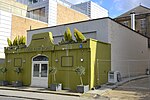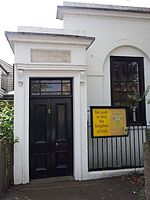Duke Street Church is an FIEC-affiliated conservative evangelical church in Duke Street, Richmond, South West London with a historical baptist tradition. Efforts from 1868 by a student pastor Frederick Brotherton Meyer started to gain traction*, and in 1869 he wrote to the Charles Spurgeon, then President of the London Baptist Association asking for his help to establish something more permanent.It initially met with forty-seven members in 1870 as Parkshot Church in an iron tabernacle, located off Park Lane. Due to a desire to be nearer the town centre, in 1878 the original church and land were sold to a group who went on to found Christ Church, Richmond. This location now corresponds to The Gateways building on Park Lane.In 1881 the first Duke Street building was completed, octagonal-shaped and built in stone in the early French Gothic style. It was listed in its trust deeds as Duke Street Baptist Chapel, a 'particular' or Calvinistic chapel. Despite struggling initially, by 1946 it had become too small to accommodate its congregation, and Sunday evening services were being transferred to Richmond Theatre.In 1950 the adjoining Victorian dance hall (Princes Hall) was bought, and in 1962 Sir Cyril Black opened the current building as Duke Street Baptist Church with a large auditorium able to seat over 600. In the early 2000s it was again renamed to the current Duke Street Church. Subsequent works have included a cafe area, meeting rooms and offices in 2010 followed by a major renovation of the auditorium completed in 2022.
Other early Baptist Groups in Richmond
Despite asserting in "The Duke Street Story 1870-1970" by Harry Young that "The first attempt to found a Baptist cause in Richmond was made in 1862", there is clear evidence around 1715-1730 of a Baptist church existing in Richmond, under Thomas Flood. In addition, by the 1850s a Strict Baptist group had formed, Rehoboth Chapel on Kew Foot Road.A disagreement in 1861 within Rehoboth Chapel led to a split, and thirteen members left to start Salem Baptist Chapel in Richmond. They met initially in rooms on Church Walk, then in 1863-1887 met in the building now known as the Dome Building on the Quadrant, but known at the time as the Mechanics Institute (from 1843), the Public Baths or the Baths (1855), and the Royal Assembly Rooms (1868). In his history of this building, A. Barkas, Borough Librarian noted being used as a Baptist Chapel after being the Royal Assembly Rooms. In1888 Salem Baptist Chapel relocated to Parkshot Road, then finally moved to Kew in 1973, becoming Kew Baptist Church before closing in 2021.
Recent Senior Ministers
The current Senior Minister, John Samuel, started in 2013. Before joining Duke Street, he was pastor at Grosvenor Road Baptist Church in Dublin.
His predecessor between 2000-2012 was Dr. Liam Goligher. Soon after leaving Duke Street, in a 2013 interview Goligher gave his view that "expository preaching in the UK has been reduced to what's described very often as a Bible talk, it's like a Bible class talk, with one main point, an opening illustration, a closing moral application, and this is among the most conservative groups in England" Goligher subsequently went on to become widely known in the United States by challenging recent teachings on the Doctrine of the Trinity which triggered the Great Trinitarian Debate. A widely-read evangelical magazine and website Christianity Today featured Liam Goligher and the Debate in a lengthy article, raising his profile even further.
All Senior Ministers - Duke Street:Church Affiliations and Inclusivity
Duke Street is currently affiliated with the Fellowship of Independent Evangelical Churches (FIEC), the Evangelical Alliance and the Affinity and South East Gospel Partnership. Sir Eric Richardson (died 2006) was a long-time member and deacon at Duke Street, receiving a C.B.E. in 1962 and knighted for his work in higher education in 1968. He was an exponent of polytechnic education who headed three institutions that have developed into universities - Salford, City and Westminster, and was a leader of 20th-century evangelical Christianity.Notes:
* John Bird died unexpectedly in an operation on May 7, 1978.
** Documentary evidence of the Senior Minister between 1978-1986 remains unclear. [needs more investigation] From George Beasely-Murray's biography, Chapter 10 we know he worked as a Church Moderator (interim for pastoral vacancies) between 1980-1986 at three churches. In order they were (1) Beckenham (2) Woodmansterne and (3) Duke Street Baptist Church. "When my father was moderator of Duke Street Baptist Church situated in Richmond, south west London, very close to the River Thames. Duke Street, for many years a very strong and staunchly evangelical church, had lost its previous minister in the unhappiest of circumstances. Relationships within the church were at rock-bottom. It was an extraordinarily difficult situation." From this it seems likely the church was without a Senior Minister for a number of years after 1978, with George Beasely-Murray arriving around (est.)1982 to serve as an interim until retiring in 1986 once Robert G.M. Amess.was appointed.









